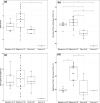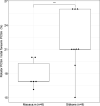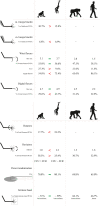The forearm and hand musculature of semi-terrestrial rhesus macaques (Macaca mulatta) and arboreal gibbons (fam.Hylobatidae). Part II. Quantitative analysis
- PMID: 33011967
- PMCID: PMC7812139
- DOI: 10.1111/joa.13314
The forearm and hand musculature of semi-terrestrial rhesus macaques (Macaca mulatta) and arboreal gibbons (fam.Hylobatidae). Part II. Quantitative analysis
Abstract
Nonhuman primates have a highly diverse locomotor repertoire defined by an equally diverse hand use. Based on how primates use their hands during locomotion, we can distinguish between terrestrial and arboreal taxa. The 'arboreal' hand is likely adapted towards high wrist mobility and grasping, whereas the 'terrestrial' hand will show adaptations to loading. While the morphology of the forearm and hand bones have been studied extensively, functional adaptations in the forearm and hand musculature to locomotor behaviour have been documented only scarcely. In this paper, we investigate the forelimb musculature of the highly arboreal gibbons (including Hylobates lar,Hylobates pileatus,Nomascus leucogenys,Nomascus concolor and Symphalangus syndactylus) and compare this with the musculature of the semi-terrestrial rhesus macaques (Macaca mulatta). Anatomical data from previous dissections on knuckle-walking bonobos (Pan paniscus) and bipedal humans (Homo sapiens) are also included to further integrate the analyses in the scope of catarrhine hand adaptation. This study indicates that the overall configuration of the arm and hand musculature of these primates is very similar but there are some apparent differences in relative size which can be linked to differences in forelimb function and which might be related to their specific locomotor behaviour. In macaques, there is a large development of wrist deviators, wrist and digital flexors, and m. triceps brachii, as these muscles are important during the different phases of palmi- and digitigrade quadrupedal walking to stabilize the wrist and elbow. In addition, their m. flexor carpi ulnaris is the most important contributor to the total force-generating capacity of the wrist flexors and deviators, and is needed to counteract the adducting torque at the elbow joint during quadrupedal walking. Gibbons show a relatively high force-generating capacity in their forearm rotators, wrist and digital flexors, which are important muscles in brachiation to actively regulate forward movement of the body. The results also stress the importance of the digital flexors in bonobos, during climbing and clambering, and in humans, which is likely linked to our advanced manipulation skills.
Keywords: adaptation; anatomy; hylobatids; locomotion; macaques; primates.
© 2020 Anatomical Society.
Figures








References
-
- Alexander, R.M.N. (2002) Tendon elasticity and muscle function. Comparative Biochemistry and Physiology ‐ A Molecular and Integrative Physiology, 133(4), 1001–1011. - PubMed
-
- Anapol, F. & Gray, J.P. (2003) Fiber architecture of the intrinsic muscles of the shoulder and arm in semiterrestrial and arboreal guenons. American Journal of Physical Anthropology, 122(1), 51–65. - PubMed
-
- Bartlett, T.Q. , Light, L.E.O. & Brockelman, W.Y. (2016) Long‐term home range use in white‐handed gibbons (Hylobates lar) in Khao Yai National Park, Thailand. American Journal of Primatology, 78(2), 192–203. - PubMed
Publication types
MeSH terms
LinkOut - more resources
Full Text Sources
Miscellaneous

